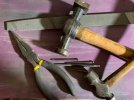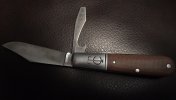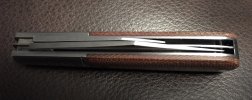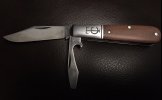- Joined
- Mar 8, 2020
- Messages
- 32
Cool to see this post of yours way back when. With the 55 you just posted in the fb group not long aho talking about how it is your most used gecs. 7 years later and it looks better than ever haha
The BladeForums.com 2024 Traditional Knife is available! Price is $250 ea (shipped within CONUS).
Order here: https://www.bladeforums.com/help/2024-traditional/
Cool to see this post of yours way back when. With the 55 you just posted in the fb group not long aho talking about how it is your most used gecs. 7 years later and it looks better than ever haha
Cool to see this post of yours way back when. With the 55 you just posted in the fb group not long aho talking about how it is your most used gecs. 7 years later and it looks better than ever haha
Absolutely beautiful!To each his or her own, but it seems a shame to store these things in tubes.
View attachment 1387584

Looks pretty cool to me on the bullet end knives...and I find it useful. Form AND function!


Joe Schmoe here, if one were inclined they could do this project with the tools in this picture if you wanted or any other blade deletes or swaps. PS don’t ever try to drill out the pins, you can start it with a drill to give the punch something to grab but the drill will go off center real fast and you start drilling through stuff you really want to still have. Also if it isn’t an all steel knife substitute the nails with nickel silver round stock that is larger than what you need and file it down. I’ve never found round stock the right size for GEC knives. 2.2+ mm is the closest drill bit size but also very hard to find.I'd much rather cut an EO notch than try a blade delete- one is way harder than the other.
Cutting an EO notch involves:
- some masking tape
- rotory tool with your favorite grinding head
- sand paper
- dye if refinishing
A blade delete involves:
- a drill press
- a ball peen hammer
- purchase of the correct diameter pin stock (probably)
- a hack saw
- a file
- sand paper
- a buffing tool of some kind
Anyone here do their own blade deletes? Craftsmen can chime in, but I'm really interested in Joe Shmoe's garage effort.




Joe Schmoe here, if one were inclined they could do this project with the tools in this picture if you wanted or any other blade deletes or swaps. PS don’t ever try to drill out the pins, you can start it with a drill to give the punch something to grab but the drill will go off center real fast and you start drilling through stuff you really want to still have. Also if it isn’t an all steel knife substitute the nails with nickel silver round stock that is larger than what you need and file it down. I’ve never found round stock the right size for GEC knives. 2.2+ mm is the closest drill bit size but also very hard to find.
Hey Josh, good to see you around here
It is fun for me to go back and see my old posts and pics as well. Amazing some of the ones I stupidly let go of lol
thanks, nice work! Could you please give us a quick summary of the steps involved? I assume you need to place the knife in a vise to punch out the pins?
This was only the second mod I did, prior to this one which is the same knife as the first one but the first time I did it I kept the blade forum blade and added a spey and cap lifter. Before these the only thing I had done was fix some blade wobble. I also didn’t have the file when I did these and used the diamond side of a fallkniven sharpener to size the nails to use as pins. The only reason I’m saying this is that I think people can do more of these things than they think they can, and I think they should. I bugs me when people just say oh I can’t do that I need too many tools or whatever other reason that shouldn’t be a roadblock. More better tools have only saved time and my shoulder from all the extra sanding. And the only power tools I’ve added are a Dremel which wasn’t the first but I would tell anyone to get that first, a 4x36 belt sander, a hand drill and a drill press. A blade swap/delete is simpler tool wise since you are not doing anything with covers (hopefully) you don’t need a saw or vise or whatever. I pound out the pins on a piece of old scrap wood on my basement floor, I think I drilled a small hole to put the pin over for it to go through more easily, you have to be careful when you pick it up because if the pin is in the wood but also still in the frame you have basically nailed the knife scale to the wood and it can bend the knife scale if you pick it up anything other than straight and gently. I’ve used the same piece of wood since I started so it has plenty of knife shaped dents in it to cradle the knives and keep them from slipping around or turning which can make things difficult. A lot of people say to cut through the pins with a razor blade, that’s not a bad way but it’s not how I started doing it so it’s usually my second go to but it works fine if you’re careful and it reduces the chances you’ll break a scale while disassembling but you can’t cut through steel pins that way. If you are doing a blade delete and it has domed pins on the knife you’ll probably want to cut through those unless you can get rid of the dome without damaging the scales which is doable with a dremel. After it’s disassembled if you cut through the pins you have to get them out of each side of the knife so you would take out any hardware that will come out, blades springs and liners then you want to cut the pins down as much as possible and file them flat as well and tap them out from the inside I don’t drill out pins but at this point you probably could as you wouldn’t be going through much material for it to get off center. Some folks also drill the holes in the knife to fit the pin stock, which is fine but I think it can change the pull on the knife. You’ll then want to size whatever pins you are using to fit the holes.1) I’ve seen your work. It’s exquisite. I’d call you more of a Joe Pro than Joe Schmoe, but I get your point- you can take one apart with very little tooling.
2) thanks for the comment on drilling. I never understood how people do that, and I’m guessing the answer is “not well”.
3) I see you’re a service provider and with that in mind I appreciate you coaching us amateurs- I know many people who keep trade secrets and I don’t hold it against them. Knowledge is valuable, and I appreciate you offering yours here!
4) that’s an oddity concerning the pin sizes on GEC’s. There’s no way they have proprietary bits and pin diameters, is there? What are the odds they would tell us the story on that?
sharp bit, better yet a machinists center bit, go slow till the bit grabs, you won’t go off center.Joe Schmoe here, if one were inclined they could do this project with the tools in this picture if you wanted or any other blade deletes or swaps. PS don’t ever try to drill out the pins, you can start it with a drill to give the punch something to grab but the drill will go off center real fast and you start drilling through stuff you really want to still have. Also if it isn’t an all steel knife substitute the nails with nickel silver round stock that is larger than what you need and file it down. I’ve never found round stock the right size for GEC knives. 2.2+ mm is the closest drill bit size but also very hard to find.
View attachment 1387632 View attachment 1387633 View attachment 1387634 View attachment 1387635
I’m certain you’re right about that. I was more saying that to fully drill out a pin from a knife is next to impossible to do well as the other end of the knife is most likely round as well and therefore almost impossible to hold straight, level, and plumb for almost any distance let alone all the way through two bolsters and how ever many blades. I have a drill press but nothing to hold anything other than my left hand which is not suitable for the job, my right isn’t either. But even if I could hold it perfectly still or had something to do it, it would probably be next to impossible to get it straight to start with. That requires more skill and equipment than I’ll ever have. It’s like an artist drawing a perfect circle.Punch the center, use a
sharp bit, better yet a machinists center bit, go slow till the bit grabs, you won’t go off center.
You wont like the answerWhich one do you miss the most?
There is no need to drill the entire pin, you only need to remove the head, the part that’s been peened to create an interference fit, once that’s done the pin will drive out easily.I’m certain you’re right about that. I was more saying that to fully drill out a pin from a knife is next to impossible to do well as the other end of the knife is most likely round as well and therefore almost impossible to hold straight, level, and plumb for almost any distance let alone all the way through two bolsters and how ever many blades. I have a drill press but nothing to hold anything other than my left hand which is not suitable for the job, my right isn’t either. But even if I could hold it perfectly still or had something to do it, it would probably be next to impossible to get it straight to start with. That requires more skill and equipment than I’ll ever have. It’s like an artist drawing a perfect circle.
Also, if for some bizarre reason you are trying to drill through, drill halfway thru, turn the piece over and drill from the other side, you have a much better chance of meeting in the center than hoping to drill from one side. As always, mark your centers carefully, smaller bit, make sure it’s sharp, use a cutting lubricant and go slow. A machinist vise can go a long way in keeping the knife plumb if you are careful setting it up, much better than hand held!I’m certain you’re right about that. I was more saying that to fully drill out a pin from a knife is next to impossible to do well as the other end of the knife is most likely round as well and therefore almost impossible to hold straight, level, and plumb for almost any distance let alone all the way through two bolsters and how ever many blades. I have a drill press but nothing to hold anything other than my left hand which is not suitable for the job, my right isn’t either. But even if I could hold it perfectly still or had something to do it, it would probably be next to impossible to get it straight to start with. That requires more skill and equipment than I’ll ever have. It’s like an artist drawing a perfect circle.
I agree 100%.I personally store mine in a drawer, out of the tubes. More because I like to look at them than any other reason.
